- Alcohol consumption in Australia
- Guidelines for safe drinking
- Prevalence of excessive daily alcohol consumption
- Standard drinks
- Blood alcohol concentration (BAC)
- Drink driving
- Steps for responsible drinking
Alcohol consumption in Australia
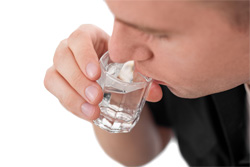
The National Drug Strategy Household Survey showed that a large percentage of Australian adults are not aware of the amount of alcohol they can consume before putting their health at risk. 44% of men and 65% of women believed that consuming two standard drinks per day would not have any negative effects on their health in the long term. In the short-term, 30% of men believed that five to six standard drinks on one occasion would not put their health at risk and 40% of women thought that three to four drinks on one occasion was acceptable. The National Health and Medical Council (NHMRC) have introduced guidelines for safe and responsible drinking. These guidelines include recommendations for maximum average weekly alcohol consumption and also for safe daily alcohol limits. It is recommended that men and women drink in moderation and avoid drinking to intoxication.
Guidelines for safe drinking
The guidelines for safe drinking were developed because the immediate effects of intoxication can cause a considerable increased risk of harm and even death. These immediate risks occur because intoxication impairs an individual’s cognition, motor skills and other abilities which usually protect the individual from accidents including falls and motor vehicle crashes.
While general guidelines have been developed, it is important to remember that there is no safe limit of alcohol consumption that can be applied to every person as it will affect everyone differently.
The general guidelines for safe drinking are:
- For healthy men and women, drinking no more than two standard drinks on any day reduces the lifetime risk of harm from alcohol-related disease or injury;
- Drinking more than two standard drinks per day increases the lifetime risk of disease and injury;
- At low levels of drinking the risk for men and women is similar, but as levels increase the risk of harm from alcohol increases more significantly for women;
- For healthy men and women, drinking no more than four standard drinks on any single occasion reduces the risk of alcohol-related injury arising from that occasion. For example, more than four standard drinks increases risky behaviour and doubles the risk of injury within the 6 hours after drinking;
- Children under 15 years are at the greatest risk of harm from drinking and should not drink alcohol. 15 – 17 year olds should also abstain from alcohol; and
- For pregnant or breastfeeding women, not drinking is the safest option. This also applies to women planning a pregnancy.
The recommendation of the Australian Cancer Council (ACC) is that individuals should limit or avoid drinking alcohol. Current evidence suggests that no amount of alcohol protects against cancer.
 |
For more information, see Alcohol Consumption: Short-Term Health Consequences. |
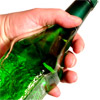 |
For more information, see Alcohol Consumption: Long-Term Health Consequences. |
Prevalence of excessive daily alcohol consumption
A significant proportion of Australians consume quantities of alcohol in excess of those recommended as safe by guidelines. 90% of Australians reported that they do not exceed the overall amount of alcohol recommended for average weekly consumption (no more than 2 standard drinks per day), however it is common for Australians to drink more than the recommended levels of alcohol in a single sitting (more than four standards drinks on a single occasion). In the 2007 National Drug Strategy Household Survey, around one third of respondents drank above the guideline levels on at least one occasion in the year before the survey. This causes alcohol intoxication and cognitive impairment and increases the risk of death or injury.
 |
For more information, see Binge Drinking. |
Standard drinks
It is important that people who intend to drink understand exactly how much alcohol they are consuming and what effects this will have in the short-term and the long-term. For many, especially younger drinkers, it is an easy mistake to assume that 1 pint of beer is equivalent to one standard drink but this is not the case.
Numbers of Australian standard drinks in common containers of various alcoholic beverages
| Alcoholic beverage | Container | Quantity | Standard drinks |
| Mid strength beer (3.5% alcohol) | 1 can or stubbie | 375 mL | 1 standard drink |
| 1 middy | 285 mL | 0.8 standard drinks | |
| 1 schooner | 425 mL | 1.2 standard drinks | |
| Full strength beer (4.9% alcohol) | 1 can or stubbie | 375 mL | 1.4 standard drinks |
| 1 middy | 285 mL | 1.1 standard drinks | |
| 1 schooner | 425 mL | 1.6 standard drinks | |
| Wine (9.5 – 13% alcohol) | Glass | 100 mL | 1 standard drink |
| Average restaurant glass | 150 mL | 1.4–1.6 standard drinks | |
| Bottle | 750 mL | 7–8 standard drinks | |
| Spirits (37 – 40% alcohol) | 1 nip | 30 mL | 1 standard drink |
| Bottle | 700 mL | 22 standard drinks | |
| Pre-mixed spirits (5 – 7% alcohol) |
1 can | 375 mL | 1.5–2.1 standard drinks |
| 1 bottle | 275 mL | 1.1–1.5 standard drinks |
Blood alcohol concentration (BAC)
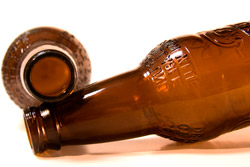
The BAC will depend on how much alcohol is consumed and over what time period. However, there are also a number of characteristics of the individual consuming the alcohol which will influence BAC and symptoms of intoxication including:
- Weight;
- Fitness level;
- Liver health;
- Alcohol tolerance;
- Mood of the drinker at the time of consumption;
- The type of drink – carbonated or “fizzy” alcoholic drinks (champagne or spirits mixed with soda) tend to raise BAC quicker than non-carbonated drinks;
- Age – younger people are often less experienced in drinking alcohol and its effects and therefore are less tolerant to alcohol;
- Mental health – people who have a mental illness or are prone to mental instability may experience heightened affects of alcohol;
- Menstrual cycle – a woman may respond differently to alcohol depending on the timing of her menstrual cycle;
- Concomitant medications – Many medications can affect, or be affected by, alcohol. Ask your doctor if alcohol interacts with any medication you are taking. A woman’s reaction to alcohol may be affected by her contraceptive or hormone replacement therapy medications.
Women will generally have a higher BAC than men after consuming the same amount of alcohol. This is because alcohol is absorbed into the body’s water and men have a higher proportion of body water than women.
A drinker’s BAC will be at its peak 30 to 60 minutes after alcohol consumption has stopped. Sometimes peak concentration will reach its peak two hours after drinking if alcohol is consumed with a substantial meal.
Alcohol is eliminated from the liver at a rate of between 4 and 12 grams per hour. There is no way to reduce the BAC other than wait for the alcohol to be eliminated.This means that drinking coffee, vomiting, taking cold showers, exercising and chewing gum will not have any effect on the rate of decline of alcohol from the blood.
Calculating BAC
It is possible to roughly calculate your BAC. Please note that this calculation will only provide a rough estimate and should not be used to determine whether you will be under the limit to drive. The only way to make sure that you remain under the limit is not to drink any alcohol.
Drink driving
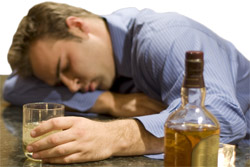
70% of fatal drink driving crashes happen in country areas. 90% of drink drivers in fatal road accidents are male and a third of drink drivers in fatal crashes are between the ages of 17 – 24.
What most people do not realise is that the consumption of any alcohol at all affects driving ability – this is why in Australia provisional drivers cannot have any alcohol in their system at all if they are driving. The legal BAC limit for non-provisional drivers is 0.05. Even at this level, there is double the risk of being involved in a car crash compared to having a BAC of zero. This risk increases exponentially as the BAC rises. At 0.01 the risk of having a car accident is seven times greater and 25 times greater at 0.15.
Alcohol affects driving by:
- Reducing reaction time;
- Reducing ability to concentrate;
- Increasing driver confidence which can lead to risk taking;
- Disturbing vision;
- Disturbing hearing; and
- Inducing a sedative affect.
A general rule of thumb is that women should have no more than one standard drink per hour if they want to remain under a BAC of 0.05. Men should have no more than 2 drinks in the first hour and one each hour following. It is important to remember that this will not apply to everyone. Some people may need to take extra precautions to make sure they remain under the limit.
Steps for responsible drinking

Tips for drinkers
- Forward thinking is an important part of responsible drinking. Drinking too much can be avoided by estimating the amount of time that you will spend out and planning how many drinks you will consume in this time. If possible, you should bring these drinks with you and only consume what is on hand.
- If you intend to consume alcohol then driving should not be an option. You should organise a lift home or make sure that you can stay the night or catch a taxi home. Importantly, depending how much alcohol you consume, you can still be over the limit the next day.
- Drink “top ups” should be avoided. Each drink should be finished before another is poured. This makes keeping track of the amount of alcohol consumed a lot easier.
- Alcohol will only be eliminated from the body with time. No matter how much food, water or coffee you consume or if you vomit, it will not lower their BAC even if it makes you feel sober.
- Drink slowly and consume non-alcoholic drinks between alcoholic drinks.
- Eating before drinking will help to fill the stomach and therefore less alcohol will be consumed.
- Avoid eating salty “snack” foods while you are drinking as this will make you thirstier and more alcohol may be consumed.
- Drinking light beer or low alcohol wine is an option to reduce alcohol content.
- Mixed drinks like cocktails should be avoided as it is hard to keep track of how many standard drinks are being consumed. Bottled drinks with a clear indication of the alcoholic volume is a good way to keep track of the number of drinks.
The only way to ensure you remain under a BAC of 0.05 is not to drink.
Tips for hosts
Responsible drinking can also be optimised when the hosts of parties do their part to ensure their guests are well looked after. Tips for party hosts include:
- Make sure there is a range of foods available for guests. Salty foods should be avoided as they will make guests thirsty.
- Make sure there is water and other non-alcoholic drinks available.
- Do not top up guest’s glasses. Hosts should wait for their guests to finish their drinks before refilling so they can keep track of how much alcohol they have consumed.
- It is important that hosts keep an eye on the intoxication level of guests and ensure that those that have had too much to drink do not drive home. It may be possible to organise a designated non-drinker that can offer people lifts home or offer guests a place to stay for the night.
- Providing entertainment – this will give people less time to drink and therefore reduce the level of intoxication at the party.
Tips for parents
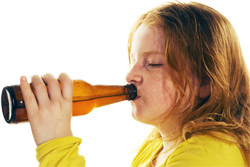
- Making sure their teenagers are aware of drink driving laws and the consequences of breaking these laws;
- Talking to their children about how to cope with peer pressure and the dangers of binge drinking; and
- Rewarding positive behaviours about alcohol.
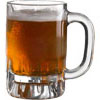 |
For more information, see Alcohol and Drinking. |
References
- Australian Guidelines to Reduce Health Risks From Drinking Alcohol [online]. National Health and Medical Research Council; 2009. [cited 2 Oct 2010]. Available from: URL Link
- Report of the DGAC on the Dietary Guidelines for Americans, 2010: Chapter D7- Alcohol [online]. Dietary Guidelines Advisory Committee; 2010 [cited 28 Sep 2010]. Available from: URL Link
- Australian Government – Department of Health and Ageing: Alcohol [online]. Department of Health and Ageing, 2010 [cited 2 Feb 2011]. Available from: URL link
- Cancer Council of Australia. Position statement: Alcohol and cancer [online]. 2008 [cited 2 Feb 2011]. Available from: URL link
- Queensland Government – Transport and Main Roads: Drinking responsibly [online]. Department of Transport and Main Roads, 2010 [cited 2 Feb 2011]. Available from: URL link
- Queensland Government – Transport and Main Roads: Anti-drink driving [online]. Department of Transport and Main Roads, 2010 [cited 2 Feb 2011]. Available from: URL link
- Australian Transport Safety Bureau: Do you know when to stop? [online] ATSB, 2011 [cited 2 Feb 2011]. Available from: URL link
- NSW Government – Transport, Roads & Traffic Authority: Accident statistics [online]. RTA, 2008 [cited 2 Feb 2011]. Available from: URL link
- Transport Accident Comission: Drink Driving Statistics [online]. TAC, 2001 [cited 2 Feb 2011]. Available from: URL link
- Government of Western Australia: Office Road Safety: Drink driving fact sheet [online]. ORS, 2010 [cited 2 Feb 2011]. Available from: URL link
- South Australia Police: Road safety [online]. South Australia Police, 2011 [cited 2 Feb 2011]. Available from: URL link
- Australian Government – Department of Health and Ageing: Alcohol and your kids: a guide for parents and carers [online]. Department of Health and Ageing, 2009 [cited 20 Mar 2011]. Available from: URL link
All content and media on the HealthEngine Blog is created and published online for informational purposes only. It is not intended to be a substitute for professional medical advice and should not be relied on as health or personal advice. Always seek the guidance of your doctor or other qualified health professional with any questions you may have regarding your health or a medical condition. Never disregard the advice of a medical professional, or delay in seeking it because of something you have read on this Website. If you think you may have a medical emergency, call your doctor, go to the nearest hospital emergency department, or call the emergency services immediately.







